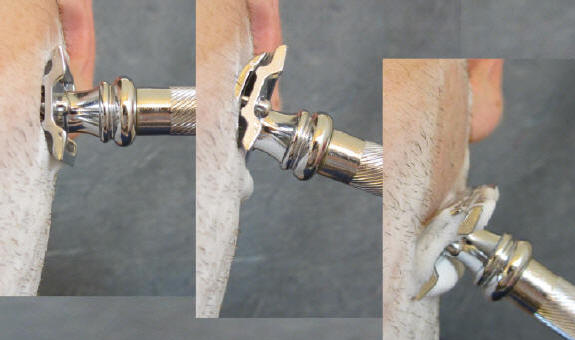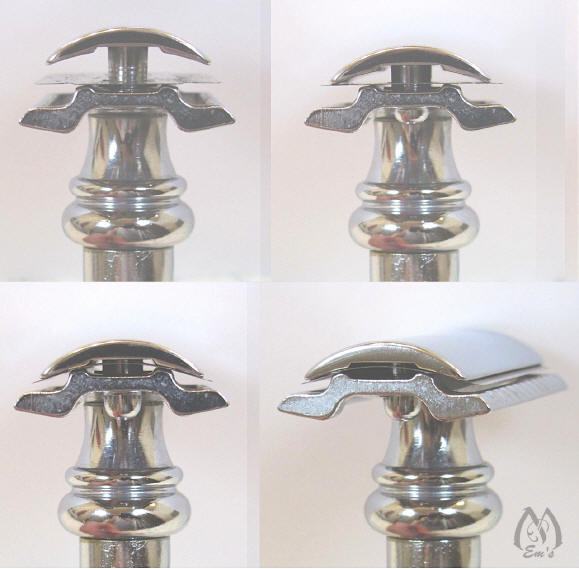I am often asked by newer double edge (DE) safety razor users about blade angle. Men using the multi-blade cartridges may have a harder time figuring out how to angle the DE. This is because during cartridge manufacture the blades are already pre-angled into the cartridge's housing and the head usually pivots, and therefore the way a cartridge handle is held can be very different than the way a DE handle is held. In addition, the approach to finding the best blade angle for your DE shave takes a little trial, and possibly some error, in the beginning.
The easiest place to learn about blade angle is on the cheek. Begin with the head of the razor pointing toward the face as shown in the first photo segment. Then start to bevel the handle downward as you slowly start to engage the blade to the whiskers and continue beveling more until you hit the "sweet spot" - typically regarded as being about a 30 degree angle to the shaving surface. Use this as a guide because various blades and razors may differ slightly.
Once you master the angle concept and gain experience with what works best for your situation you will be able to apply this to more difficult shaving areas. With patience you will be able to obtain close, comfortable and nick-free shaves.
What is the DE shaving "sweet spot"? It is when the blade cuts through the stubble so effortlessly you think no whiskers have been removed because it was so smooth you think nothing happened - when it did.
______________________________
This photo is to help demonstrate the concept of starting with the head of the razor facing the area to be shaved and then the handle being beveled down until the blade makes contact with the skin and cuts the whiskers cleanly and smoothly.

Q. Why is it that one person will report they get nick-free DE shaves, even from the start, while others will report that months later they still get cuts?
The biggest culprits are: incorrect blade angle, too much pressure, whiskers not softened enough, direction of whisker growth, shaving too fast and/or not paying attention. Other considerations are the blade and/or razor. Sometimes there can be a "bum" blade in a pack so change the blade if you suspect this could be a factor. Further, some blades are sharper than others and perform differently in various razors, therefore try different brands to see what works best for you. In regard to the DE razor, some are considered more aggressive than others (how much blade is exposed between the upper platen and lower platen that sandwiches the blade) which is why trying different blades can be important. In the event you are using an adjustable DE, perhaps dialing back the blade gap to a lower, and hence, less aggressive setting may help. You can see in the DE picture below an example of how the safety razor platens bow the blade when the head cinches the blade in place. So, if you are getting nicks after using the DE for a while, revisit the basic concepts with a fresh perspective and don't give up because you can enjoy a DE safety razor shave with satisfaction and enjoyment too.
_______________________________
This series of pictures show the Merkur 38C (a two part razor) blade being loaded. Picture one: the head/top with screw rod stem has just been put in place. Picture two: the head has started to be screwed down in place and just meeting the blade. Picture three: the head is now fully tightened over the blade and you can see the "bow" in the blade. Picture four: another angle of the fully closed head.

_______________________________
You can see in the photos below several different cartridge types and how they are angled. You can get a good visual idea about how come the more blades there are in the razor cartridge, the more likely for the blades to simply slide/ski over the whiskers when more than a day or two of growth is present. This is why if a person waits for more than two days or has a very heavy stubble the DE can be a better option. With a DE the single edge of the blade will cut the hairs more cleanly, rather than ski over them while tugging and pulling. See our vicious circle article for more about this subject.
Fusion Cartridge

Mach3 Cartridge

Sensor Cartridge

TracII Cartridge

Please note: The Gillette® Fusion™, Mach3™, Sensor™ and TracII™ are registered trademarks of The Gillette Company. Em's Place is not affiliated with The Gillette Company.
